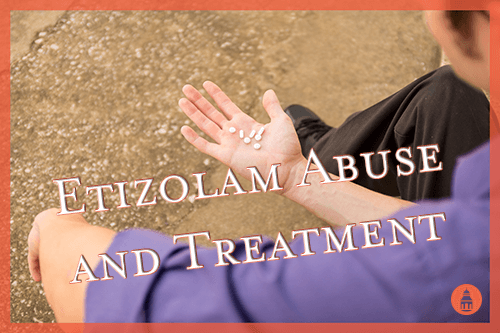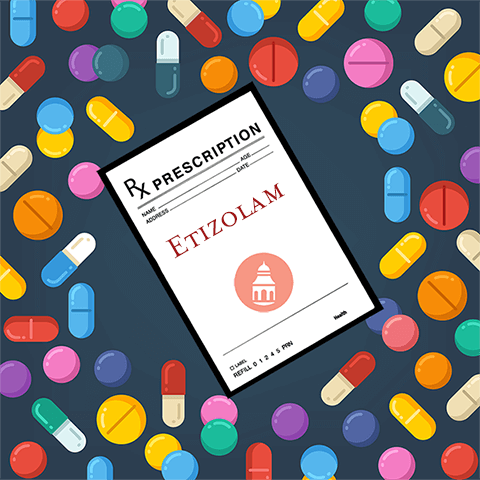 Etizolam is the generic name for a medication related to benzodiazepines. It belongs to the thienodiazepine class of chemicals, which features several substances that act on the GABA receptors in the brain. Etizolam is stronger and longer-lasting than benzodiazepine medications, such as Valium, Klonopin, or Xanax. Because of the substance’s potency differences, etizolam is not legal in the United States and much of Europe, although it is legal to prescribe this medication to treat some conditions in Japan, India, and Italy.
Etizolam is the generic name for a medication related to benzodiazepines. It belongs to the thienodiazepine class of chemicals, which features several substances that act on the GABA receptors in the brain. Etizolam is stronger and longer-lasting than benzodiazepine medications, such as Valium, Klonopin, or Xanax. Because of the substance’s potency differences, etizolam is not legal in the United States and much of Europe, although it is legal to prescribe this medication to treat some conditions in Japan, India, and Italy.
How Does Etizolam Affect the Brain and Body?
- Reduced anxiety
- Reduced seizure risk due to its work as an anticonvulsant
- Increased ability to sleep due to its sedative-hypnotic effects
- Muscle relaxation
While the chemical structure is like that of a benzodiazepine, the small differences mean that etizolam is between six and ten times more powerful than diazepam, the generic version of Valium. Like benzodiazepines, etizolam and thienodiazepines can rapidly lead to physical dependence, tolerance, and have similar reward system-stimulating, rewarding effects.
Etizolam is such a potent central nervous system (CNS) depressant, it acts similarly to powerful sedatives like barbiturates.
The drug is not listed in a schedule through the Controlled Substances Act (CSA), but it has not been approved for use in the US, so possession of this drug by Americans indicates abuse.
Etizolam Abuse
According to the Drug Enforcement Administration (DEA), people of all ages, genders, and socioeconomic classes may abuse etizolam. The drug is sold online and occasionally in head shops where it is marketed as a research chemical that is “not for human consumption.”
It is not widely abused in the US, but more people are reportedly taking the substance. The National Forensic Laboratory Information System (NFLIS) reported three instances of etizolam seizure by the DEA in 2012. In 2013, there were 92 seizures of the illicit substance, and in the first six months of 2014, there were 45 reported seizures. Between October and December 2015, the San Francisco branch of the California Poison Control System reported that eight individuals were hospitalized because they consumed counterfeit, likely illicit, alprazolam tablets; these tablets primarily contained fentanyl, a dangerous opioid drug, but some contained etizolam. Before 2012, however, there were no reports of etizolam being seized by law enforcement.
Prescription Etizolam vs. Illicit Abuse
As a prescription medication in other countries, etizolam may be found in tablet form; however, since it is not a legal prescription medication in the United States, it is more often found in powdered form.
Etizolam was first introduced in Japan in 1983 as a prescription medication treating neurological conditions, including anxiety, insomnia, and panic attacks. Currently, the drug is prescribed in 0.25 mg, 0.5 mg, and 1 mg tablets. Some medical studies have suggested that etizolam can replace the barbiturate drug pentobarbital because it lasts longer and has fewer dependence or addiction-related side effects. Some prescription uses of etizolam in other countries may include sedation prior to surgery, as muscle relaxants or antipsychotics, and for similar short-term needs.
In the US, benzodiazepine abuse is widespread. People who struggle with Klonopin, Xanax, Valium, and related drugs may escalate their abuse of these substances as their bodies develop a tolerance to the presence of these GABA agonists.

Some people may feel that they need more of these benzodiazepine medications than they can acquire or that large amounts take too long to become effective. This may lead them to illicitly purchase and abuse etizolam, to achieve similar sedative effects.
Signs of Etizolam Intoxication
Signs of intoxication on etizolam are like those associated with benzodiazepines. They may include:
- Drowsiness
- Sedation
- Muscle weakness
- Loss of coordination
- Fainting
- Headaches
- Confusion
- Depression or mood changes
- Slurred speech
- Visual changes or disturbances
The main indicator of etizolam abuse, or a serious side effect, is daytime drowsiness. While there are many medications that can cause this, if a person has not received a prescription for a sedative medication and begins to become drowsy or excessively sleepy during the daytime, they may be abusing a CNS depressant of some kind, including etizolam. Etizolam’s half-life is about 3.4 hours, so the effects peak anywhere between three to five hours, or six to eight hours, depending on dosage.
Other indicators that someone may be abusing etizolam include:
- Behavioral changes
- Disturbing dreams or nightmares
- Memory loss
- Hostile behavior
Overdose and Other Health Issues Associated with Etizolam
Since etizolam is more potent than its benzodiazepine counterparts, overdose may appear similar to an overdose of Valium, or it may have symptoms closer to those associated with barbiturates.
Etizolam is being imported illicitly into the US and sold as a substance of abuse, but some may purchase the drug as a date rape drug. Since etizolam is very potent, it creates an amnesia-like effect and lowers inhibitions like alcohol does; a person who has been given etizolam may not remember what happened to them.
Get Help with Etizolam Abuse
Withdrawal symptoms associated with benzodiazepines, which may be part of etizolam abuse, include:
- Increased anxiety or paranoia
- Insomnia or other sleep disturbances
- Seizures
These are likely to begin as the drug wears off, after about eight hours; peak withdrawal symptoms occur between three and five days after the last dose. During this time, the person who stopped taking etizolam is at much greater risk of relapsing back into substance abuse, so their risk of experiencing an overdose is much higher.
To safely detox, avoid relapse and overdose, and reduce the risk of life-threatening seizures, it is important to work with an addiction specialist who understands etizolam addiction and benzodiazepine abuse. An addiction specialist can manage withdrawal using a tapering program and a replacement benzodiazepine; then, they can ease the person into a comprehensive rehabilitation program. Therapy is the backbone of addiction treatment, helping individuals to cope with relapse triggers and find firm footing in recovery.
It’s Never Too Late to Get Help
Get Help Now.
Has addiction stolen your loved one? Take action and call (619) 577-4483 or fill out this form to speak with a Treatment Consultant about our drug rehab center or one of our facilities across the United States.
